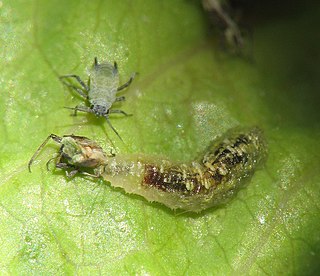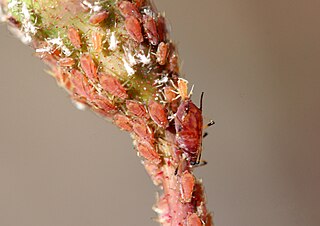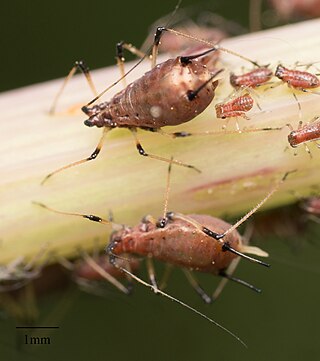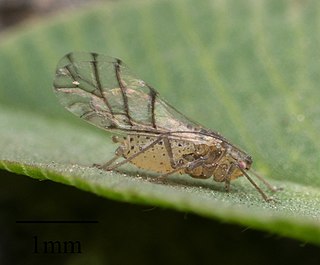
Biological control or biocontrol is a method of controlling pests, whether pest animals such as insects and mites, weeds, or pathogens affecting animals or plants by using other organisms. It relies on predation, parasitism, herbivory, or other natural mechanisms, but typically also involves an active human management role. It can be an important component of integrated pest management (IPM) programs.

Aphids are small sap-sucking insects and members of the superfamily Aphidoidea. Common names include greenfly and blackfly, although individuals within a species can vary widely in color. The group includes the fluffy white woolly aphids. A typical life cycle involves flightless females giving live birth to female nymphs—who may also be already pregnant, an adaptation scientists call telescoping generations—without the involvement of males. Maturing rapidly, females breed profusely so that the number of these insects multiplies quickly. Winged females may develop later in the season, allowing the insects to colonize new plants. In temperate regions, a phase of sexual reproduction occurs in the autumn, with the insects often overwintering as eggs.

Cirsium arvense is a perennial species of flowering plant in the family Asteraceae, native throughout Europe and western Asia, northern Africa and widely introduced elsewhere. The standard English name in its native area is creeping thistle. It is also commonly known as Canada thistle and field thistle.

Plum pox, also known as sharka, is the most devastating viral disease of stone fruit from the genus Prunus. The disease is caused by the plum pox virus (PPV), and the different strains may infect a variety of stone fruit species including peaches, apricots, plums, nectarine, almonds, and sweet and tart cherries. Wild and ornamental species of Prunus may also become infected by some strains of the virus.

The black bean aphid is a small black insect in the genus Aphis, with a broad, soft body, a member of the order Hemiptera. Other common names include blackfly, bean aphid, and beet leaf aphid. In the warmer months of the year, it is found in large numbers on the undersides of leaves and on the growing tips of host plants, including various agricultural crops and many wild and ornamental plants. Both winged and wingless forms exist, and at this time of year, they are all females. They suck sap from stems and leaves and cause distortion of the shoots, stunted plants, reduced yield, and spoiled crops. This aphid also acts as a vector for viruses that cause plant disease, and the honeydew it secretes may encourage the growth of sooty mould. It breeds profusely by live birth, but its numbers are kept in check, especially in the later part of the summer, by various predatory and parasitic insects. Ants feed on the honeydew it produces, and take active steps to remove predators. It is a widely distributed pest of agricultural crops and can be controlled by chemical or biological means. In the autumn, winged forms move to different host plants, where both males and females are produced. These mate and the females lay eggs which overwinter.

Macrosiphini is a tribe of aphids in the subfamily Aphidinae.

Brachycaudus helichrysi is a species of aphid first described by the German naturalist Johann Heinrich Kaltenbach in 1843. Its common names include leaf curl plum aphid, and leaf-curling plum aphid, and it is a serious pest of plum and damson trees.

Brachycaudus cardui is a species of aphid, commonly known as the thistle aphid or the plum-thistle aphid. It infests trees in the genus Prunus in the spring and autumn, and mostly plants in the aster family in the summer.

Uroleucon sonchi is a species of aphid in the family Aphididae. Known as the large sow-thistle aphid, it is a native of Europe, and has been introduced to several other countries. It principally feeds on the sow thistle but is also a pest of cultivated lettuce, and so is also known as the brown lettuce aphid.
Hayhurstia is a genus of aphids in the family Aphididae. There is one described species in Hayhurstia, H. atriplicis.

Formica neoclara is a species of ant in the family Formicidae. It is a generalist that has been known to have mutualistic relationships with 42 different species of aphids.
Sarucallis, also known by its common name as the Crape myrtle aphid or Kirkaldy, is a genus of aphids in the family Aphididae. There is one described species in the genus Sarucallis and it is Sarucallis kahawaluokalanu (S. kahawaluokalani). They can grow to a body length of 1.2 to 1.8 millimeters.
Sitobion luteum, the orchid aphid, is a species of aphid in the family Aphididae. It is found in Europe.

Sitobion is a genus of aphids in the family Aphididae. There are more than 80 described species in Sitobion.

Ceroplastes is a genus of wax scales in the family Coccidae. There are more than 130 described species in Ceroplastes.

Capitophorus is a genus of aphids in the family Aphididae. There are more than 30 described species in Capitophorus.

Hyperomyzus lactucae, known generally as the blackcurrant-sowthistle aphid or sow thistle aphid, is a species of aphid in the family Aphididae. It is found in Europe.

Therioaphis trifolii, the yellow clover aphid, is a species of aphid in the family Aphididae. It is found in Europe.
Therioaphis is a genus of aphids in the family Aphididae. There are more than 20 described species in Therioaphis.














